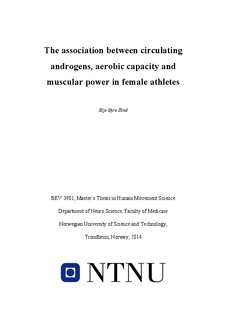| dc.description.abstract | Previous research has focused primary on the effects of testosterone supplementation
and circulating androgen influence on physical performance among men. However
the relationship between physical performance and natural variations of androgens in
female athletes is a relatively unexplored field, thus further research on females and
androgens are necessary. The primary aim of this study was to analyze the
relationship between baseline androgen hormones, VO2 max and maximal power in
female athletes from three different sports. Due to the physical differences between
sports, we also examined these relationships within the three different groups of
female athletes; handball players (n=17), soccer players (n=24) and cross-country
skiers (n=16). 57 females aged 18-34 years participated in the study. VO2max was
determined while running. Jump power was measured with squat jumps (SQJ) on a
force platform, and a standard bench press test was used to measure the upper body
power. Standard procedure blood samples were taken to measure the levels of
testosterone (T), anti muller hormone (AMH), androstendione, sex hormone binding
globulin (SHBG), free testosterone index (FTI), dihydroepiandrostendione (DHEA)
and hydroepiandrostendionesulfate (DHEAS). A significant negative association
between VO2max and FTI was found in the cross-country skiers (r=-0.760, p=0.001)
and a positive relationship was found between FTI and SQJ power (r=0.620,
p=0.014), and SHBG and VO2max(r=0.459, p=0.034). Moreover, a negative
correlation was found between DHEA and maximal power produced in bench press
(r=-0.578, p=0.024). No association was found between androgens and physical
performance in the handball or soccer players. In conclusion no significant
association between androgens and the physical performance was found when the
female athletes were analyzed as a group. However, in the endurance-trained athletes,
androgens appear to have a complicated relationship with performance, where
VO2max is negatively, and maximal SQJ power is positively correlated with
androgens.
Key words: Androgens, female athletes, VO2max, muscular power | nb_NO |
